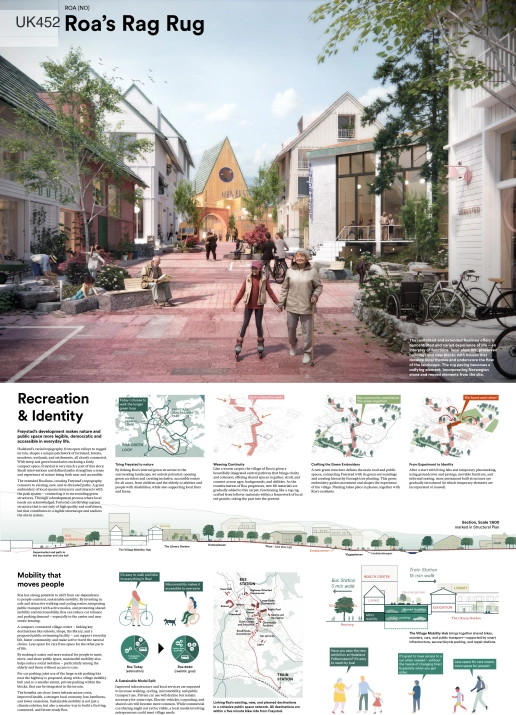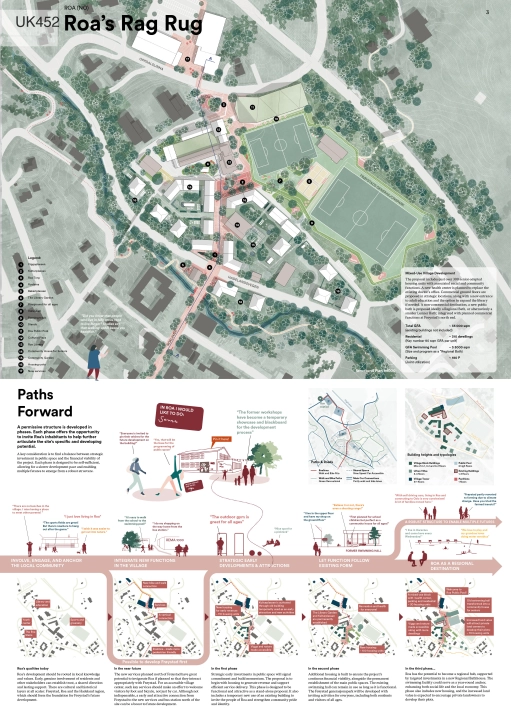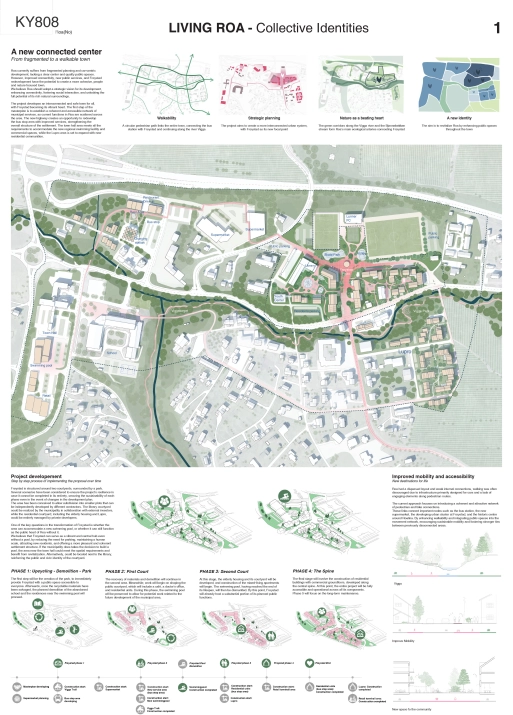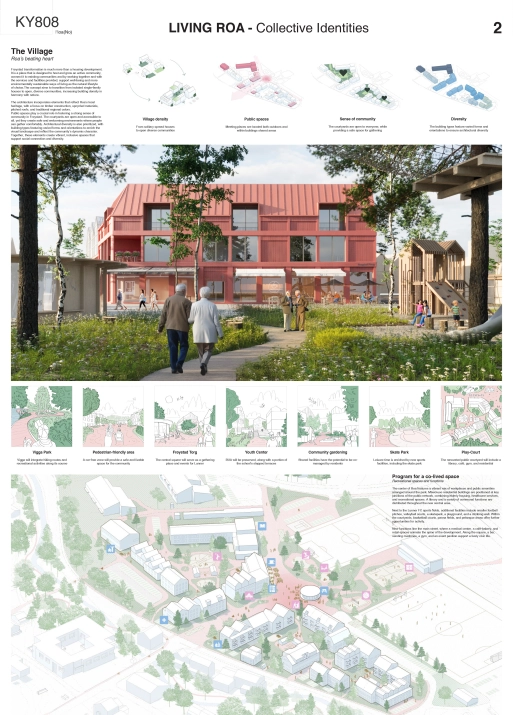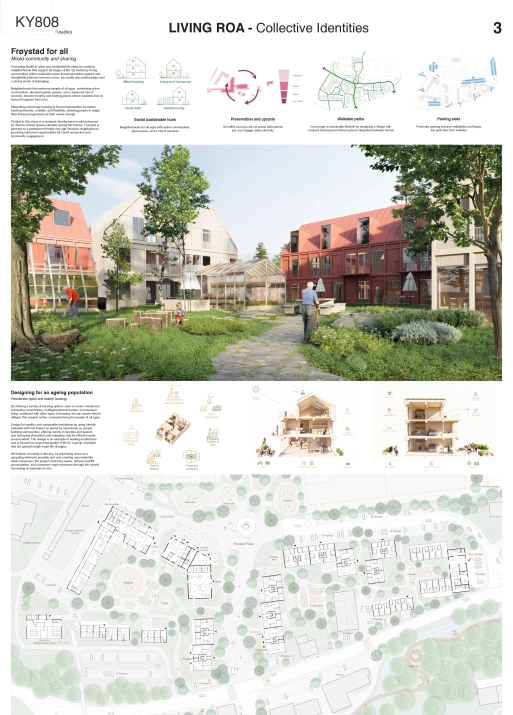Roa’s Rag Rug won the competition in Roa!
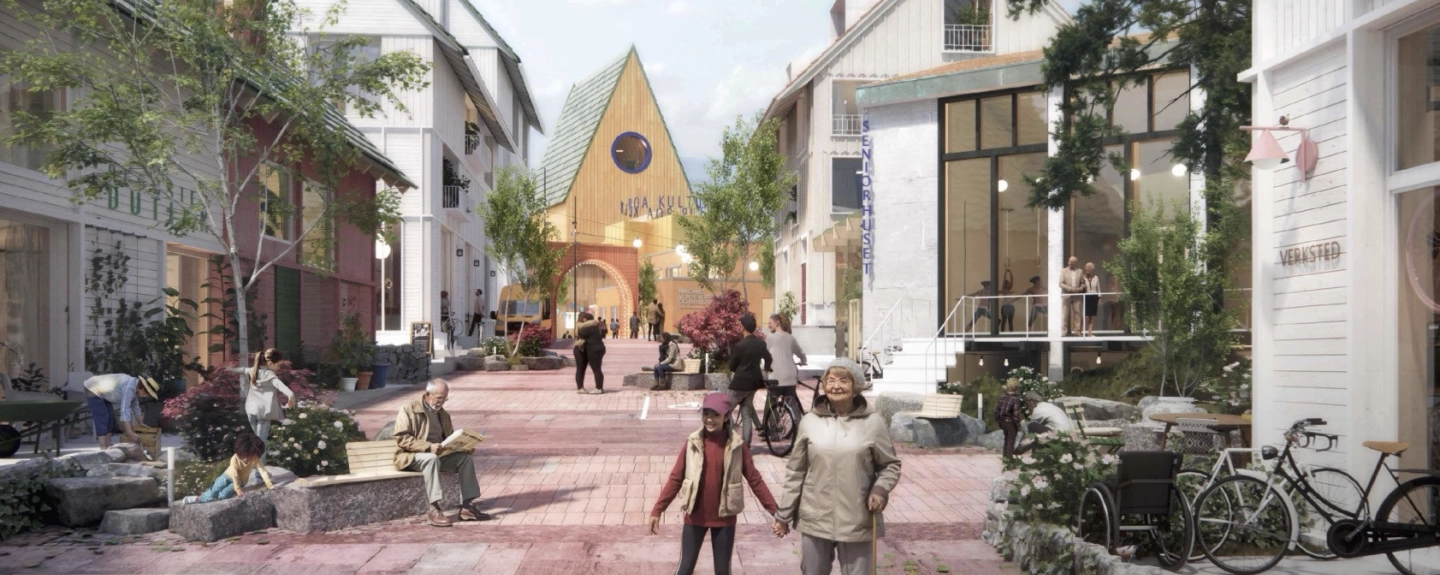
The project Roa’s Rag Rug by Joanna Attvall, Isabella Landtreter, Mikael Pettersson, Josephine Philipsen, David Ottosson won the competition in Roa!
General Remarks by the jury
From a national urban planning perspective, Roa is highly interesting. In many ways, it represents the majority of small Norwegian towns that for decades have struggled to prevent sprawl, resulting in a historical center that is all but eroded of meeting places and public space. Several past attempts at planning a revitalized center have failed because the proposals did not successfully understand the local scale or infuse the village with a renewed sense of identity. Now, however, demographic changes create a new imperative for reurbanizing the center: Lunner municipality requires up to 300 new dwellings for the elderly. Without a dense, walkable village structure where an older population can easily access stores and receive health services efficiently, the municipality will be unable to provide the statutory services required. Lunner is wisely approaching this issue as an opportunity to renew the village’s identity and make it attractive to people of all ages.
Roa is a small village situated in Hadeland, one of Norway’s most fertile agricultural regions, located where the Vigga river flows northward through Viggadalen. Grown along the Gjøvik railway, Roa's name means "corner," reflecting its unique north-facing position in Eastern Norway. The village is characterized by open landscapes and generous space between houses, with Hadelandveien running through it. The strengthening of Roalinna as the village’s main street and transport hub is logical and promising, marking the beginning of crucial urban development.
One of the key challenges in planning Roa’s future development is finding the appropriate scale and degree of urbanization. The right balance between necessary growth and realism is essential to ensure that the expansion feels both achievable and contextually grounded. The question is how much new area can be added while still supporting a credible and sustainable transformation. At the same time, the plan must create conditions for active public life, shared spaces, and everyday interaction. Housing and social sustainability are central to the task, demanding a convincing housing structure that accommodates diverse groups and lifestyles. Increasing housing density in central areas is necessary to support local functions and ensure walkable distances between key destinations. This introduction of a new level of density also requires careful design of the transition between private and public realms to ensure both a vibrant urban character and high-quality living environments. These thresholds are key to creating a sense of community and comfort in a denser village setting.
Crucial as a strategy for the development of smaller municipalities is the establishment of robust infrastructure. Water, sewage, and a continuous network of sidewalks designed on the site’s and pedestrians’ terms are prerequisites for dense living and good towns. The jury strongly believes that the municipality must take charge of developing the street plan and strong public spaces first to effectively manage densification and invite investors to create a framework where all infrastructure is included. Then, the buildings can develop gradually, as needed, as the housing market evolves. Development in smaller municipalities with limited budgets must be attractive enough for investors to engage, requiring the proposal to explore how to stimulate investment and reverse the trend affecting many rural areas.
The jury’s discussions consistently focused on the broader vision for Roa, particularly how to connect the existing areas and foster a strong sense of belonging. We explored how spatial organization, housing typologies, and public spaces could support everyday social interaction and strengthen local ties. The selected proposals stood out for their ability to inspire, excite, and generate optimism about Roa’s future development. They present clear, flexible strategies that can be developed in phases. Our primary strategic advice to the municipality is to utilize zoning regulations and development requirements to ensure that all necessary public spaces and street plans are fully in place before construction begins or buildings are approved for use. Densifying around existing key meeting places—the school, cultural institutions, and sports facilities—remains the soundest strategy for Roa’s future growth.
Download the full report for feedback on projects
Team
Joanna Attvall (SE), architect urbanist
Isabella Landtreter (SE), architect
Mikael Pettersson (SE), architect
Josephine Philipsen (SE), landscape architect
David Ottosson (SE), architect urbanist
Jury remarks
“This project can create dreams.” The storytelling in Roa’s rag rug is compelling and evocative.
The winning proposal presents a convincing narrative through Roa’s places, function, and experiences. The red axis acts as a strong backbone through the village, connecting Roa Station via Roalinna, across Hadelandsveien, and up past the old school buildings to a new square near the sports fields. This spatial sequence continues northward toward the swimming hall, bus station, and future residential development. The project skillfully combines existing identity with strong placemaking strategies and highlights movement, connectivity, and shared life as central themes. It reveals and enhances the qualities of Frøystad, making them accessible to all, and proposes a rich and playful concept for all generations and seasons.
The proposal demonstrates a thoughtful balance between history and future development, with engaging ideas around the relationship between private and public spaces, meeting points, and visual connections. It encourages outdoor activity, walkability, and social interaction—promoting health and counteracting loneliness. The project shows a strong commitment to reusing and reinforcing existing local functions, which adds depth and continuity to the proposal. It places clear emphasis on sports, culture, and the care centre as central anchors in the urban structure, creating meaningful meeting places for the community. These elements contribute to a socially inclusive and place-specific strategy that supports everyday life and long-term development in Roa. Existing local functions such as Lupro, car services, and small-scale commercial programs are reinforced, and the process includes active participation from local residents. The use of local red natural stone in public spaces introduces pride and identity into the built environment, and the continuation of Roalinna up to the school generates a variety of spatial experiences. The proposed building typology contributes to a dynamic and coherent streetscape.
The project’s housing strategy presents a promising framework that can be further refined to strengthen its urban impact. The scale feels well-considered and appropriate for Roa, but there is an opportunity to increase density to support a more vibrant and sustainable urban plan. Including ground floor plans in the presentation would enhance the understanding of how public and private zones interact. This could help clarify transitions and support active street-level engagement. The emphasis on sports as a central element is strong and well-considered, offering a solid foundation for community engagement. However, it may be worth reassessing the relocation of the football field to ensure the benefits justify the potential costs. The proposal outlines an ambitious vision for public investment, including a new health centre, library, adult education facilities, and a public bath. To fully realize this vision, further work is needed on long-term financing strategies and the activation of ground-floor spaces with public functions. The plan is good on walkability, but the current village sprawl and car-dependence—especially in steep terrain—pose challenges. Sidewalks along Roalinna and Hadelandsveien are essential, and the new street must balance social life, commerce, parking, goods delivery, and snow storage. Further development of the plan could be a master plan or a street plan, where there is a good balance between sidewalks, street, parking, and goods delivery, so that Roa can flourish again as a pleasant station town in Hadeland.
In summary, the proposal offers a flexible and robust strategy with a clear vision for Roa’s identity and scale. It presents a strong urban concept with rich storytelling and placemaking, and has the potential to transform Roa into a vibrant and people-centered station town. With further development—particularly in housing, traffic solutions, and street design—the project could successfully support a compact, walkable village structure that encourages community life and sustainable growth.
Team
Samuele Agrimi (IT), architect
Fabio Bari (IT), architect
Jury remarks
This proposal presents a clear extension of Roalinna up to Frøystad, integrating key public institutions such as a library, skatepark, and other sports attractions. The east-west axis along the Vigga river and the park structure, including the riverside promenade along Hadelandsveien, is well illustrated in the site plan. The public street is marked in red, emphasizing its role in the urban structure. However, the plan would benefit from a more detailed discussion on the relationship between sidewalks, carriageways, parking, and goods delivery to ensure the space functions well throughout the day and across seasons.
The concept is nature-based, accessible, and strategically rooted in existing identity. It marks an important first step in connecting Roa’s municipal functions and demonstrates a strong analysis of the village. The proposal strengthens existing qualities along the river and connects key elements of the urban fabric. The housing is well scaled and appropriately dense, with convincing neighborhood qualities and a strong relationship to context. It supports diverse living arrangements and includes places for social interaction. The subdivision of plots and scalability of the plan are thoughtfully considered, and the illustrated fragments convey the project’s spatial qualities.
Despite its strengths, the main square feels oversized and under-programmed, and the lack of a clear and readable enclosing edge diminishes its spatial character. The round building appears too modest and disconnected from its surroundings, and the orientation of outdoor restaurants is unclear. The architectural identity is generic and lacks the centrality needed to create a strong village core. Public spaces feel dispersed and do not fully achieve the desired human scale, making the overall urban design appear somewhat diluted.
In summary, this is a thorough and realistic proposal with strong housing solutions and a holistic understanding of Roa. It addresses many aspects of village life. However, the project would benefit from a clearer urban design, stronger spatial concentration, and a more distinctive identity.

